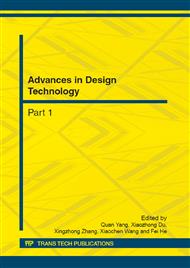p.395
p.399
p.407
p.419
p.426
p.433
p.438
p.443
p.447
Uneven Granular Module Clustering and Intelligent Optimization for Customizable Products
Abstract:
To solve the problems of the traditional approach to uniform granular module clustering, a new method for module clustering based on uneven granularity and intelligent optimization oriented to the customizable product design was proposed. Considering the impacts of requirements, functions and structures, the integrated fuzzy similarity matrix of parts was built using the correlativity analysis, and then the hierarchical structure was generated through a fuzzy clustering algorithm. All the universes of the granular layers in the hierarchical structure were gathered and the uneven granular module clustering scheme was formally presented. Four quantified indices including customizability index, customer satisfaction degree, design complexity and assembly complexity, were proposed to set up four optimization objective functions. Use nondominated sorting genetic algorithm II to solve the problem in order to obtain the Pareto optimal set. A design case of the single mast storage/retrieval machine was studied to demonstrate the feasibility of the proposed method.
Info:
Periodical:
Pages:
426-432
Citation:
Online since:
November 2012
Authors:
Price:
Сopyright:
© 2012 Trans Tech Publications Ltd. All Rights Reserved
Share:
Citation:


